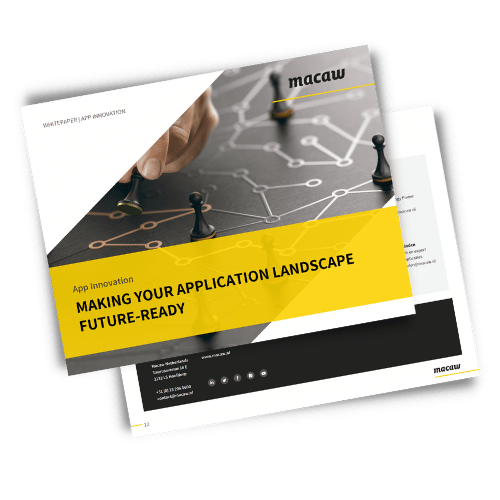Let’s take a look at the market.
A construction company or factory isn’t your typical IT environment. Technology doesn’t pervade every corner of the company, and the extent to which employees work with IT varies widely. The need for further technological development in this sector is nothing new. But how should that be achieved? Tata Steel’s approach is to scrutinize its many hundreds of applications and update them as needed. By contrast, the VDL group, a bus and car manufacturer, has opted for creation of a completely new application.
Customers’ demands and the requirements of technology necessitate a complete reorganization of businesses. Until recently, cars were sold primarily through the dealer network. It’s far from unlikely, though, that you bought your current car directly from the manufacturer. The newer auto brands already operate this way, and they’re also taking full control of maintenance. Cars are no longer taken into the workshop for a service; instead, they’re plugged into a special “shop” and “updated”.
The same is happening in other sectors, such as that of heat pumps and boilers. The suppliers take care of maintenance, eliminating the middlemen – in this case, the plumbing sector. The appliances themselves are also becoming more and more digital; their data can be read out and updated remotely. This switch to a B2C relationship is quite extraordinary for a sector that in the past operated primarily on a B2B basis.
This change requires a different setup for the application landscape, which is where app innovation comes into play. Organizations are often driven by innovative concepts and the development of new business models delivering faster production, more efficient working and reductions in waste.
How is the application landscape to be set up?
In the drive for innovation, the need for the application landscape to be revamped and migrated to the cloud is often overlooked. In this respect, manufacturing is not the most cutting-edge of industries. Applications are often still running locally, and with little or no communication with other applications. In some cases, information is entered at three different points, but the time isn’t taken to build a new interface connecting the three apps.
The 6 R method helps to provide an overview of the applications and a visual answer to your questions regarding the landscape. The title refers to the six possible strategies for each application. Will you opt to retain the application in its current form, or create a completely new application? Will you merely revise the app, or rebuild it from scratch?
In the 6 R approach, you map out the applications that can be retired, merged or rebuilt, respectively. The reality is that without such an approach, large organizations don’t get round to upgrading their application landscape. Tata Steel, for example, has more than 1,200 virtual machines in operation. This is simply too many to modernize at short notice. For this reason, the company launched its complexity reduction program. Tata Steel had a heavy administrative overhead with substantial manual work, and processes that were not interconnected. All new solutions were built using the low-code Power Platform. As a result, the company is making great strides in automation.
Major benefits
These begin with migration to the cloud. This is not an end in itself, but the starting point for the subsequent steps. Merely migrating your application landscape to the cloud does not make it scalable, reliable and secure. In addition, behind the applications there’s often still a software monolith, hindering your agility. Or your applications are running on a virtual machine (VM), and you regard that as sufficient, considering that all necessary investment for it has already been made. A virtual machine is more expensive than hosting an application natively in the cloud. But if you do take these steps, the switch will deliver major benefits for your organization in the following three areas:
- Agility and speed. With an up-to-date and agile application landscape, you’re better equipped to respond to customer needs, which are always in a state of flux.
- Efficiency and cost savings. Cloud native applications enable you to scale up and down in response to increases and decreases in data traffic. You pay only for what you use. Managing and maintaining your application landscape is also much more economical in the cloud.
- Security and compliance. Legislation and regulations are subject to constant change. As a result, full compliance is becoming an increasingly complex issue for manufacturing companies. Modernizing the application landscape also raises the security level. In cooperation with your cloud and application providers, you thereby ensure that you’re always in full compliance with the current legislation and regulations.
Modernizing the application landscape has another huge benefit: with all the applications better matched to each other, merged or given an additional layer, scope is created for real innovation.
Following through and future-proofing your application landscape has both a technical and an organizational component. This goes beyond merely choosing a microservices architecture, for example, and in fact encompasses all MACH principles (microservices, APIs, cloud-first and headless).
The organizational component is also a prerequisite for successful modernization of your applications. It involves selective deployment of your development capacity, to enable your developers to concentrate on the tools and systems that deliver the greatest value to your organization. These applications will in all probability also be related to your unique selling propositions. This is the path to your future success. Curious about the initial steps we can take together? Contact our experts; they are eager to assist you. Alternatively, you can read our whitepaper on App Innovation.








